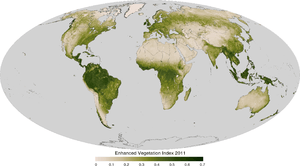Enhanced vegetation index
The enhanced vegetation index (EVI) is an 'optimized' vegetation index designed to enhance the vegetation signal with improved sensitivity in high biomass regions and improved vegetation monitoring through a de-coupling of the canopy background signal and a reduction in atmosphere influences. EVI is computed following this equation:

where NIR/red/blue are atmospherically-corrected or partially atmosphere corrected (Rayleigh and ozone absorption) surface reflectances, L is the canopy background adjustment that addresses non-linear, differential NIR and red radiant transfer through a canopy, and C1, C2 are the coefficients of the aerosol resistance term, which uses the blue band to correct for aerosol influences in the red band. The coefficients adopted in the MODIS-EVI algorithm are; L=1, C1 = 6, C2 = 7.5, and G (gain factor) = 2.5.
Whereas the Normalized Difference Vegetation Index (NDVI) is chlorophyll sensitive, the EVI is more responsive to canopy structural variations, including leaf area index (LAI), canopy type, plant physiognomy, and canopy architecture. The two vegetation indices complement each other in global vegetation studies and improve upon the detection of vegetation changes and extraction of canopy biophysical parameters.
.[1]
Another difference between Normalized Difference Vegetation Index (NDVI) and EVI is that in the presence of snow, NDVI decreases, while EVI increases (Huete, 2002).
Starting 2000, and after the launch of the two MODIS sensors on Terra (satellite) and Aqua (satellite) by NASA, EVI was adopted as a standard product by NASA and became extremely popular with users due to its ability to eliminate background and atmosphere noises, as well as its non saturation, a typical NDVI problem.[2] EVI is currently distributed for free by the USGS LP DAAC.[3]
Two-band EVI
Two reasons drive the search for a two-band EVI:
- Extending the EVI back in time, using the AVHRR record. The AVHRR sensors lacks a blue band, hence using a three-band EVI version is not possible. This could potentially lead to a 30-year EVI record that complements the NDVI record.
- The blue band has always been problematic, and its Signal to Noise ratio (S/N) quite poor. This is mainly due to the nature of the reflected energy in this part of the spectrum over land, which is extremely low.
As such, there are currently proposals to design a 2-band EVI. In designing this two-band EVI a non-physically based mathematical approach is employed. We'll call the two-band EVI, EVI_2, and the three-band EVI simply EVI:
Approximate EVI by EVI2, where EVI_2=f(red,NIR)
f(red,NIR) = G*((NIR-RED)/(L+NIR+C*Red))
Find G,L, and C with G as (organic) that minimize the difference between EVI_2 and EVI
This leads to multiple (infinite) solutions but few conditions could
be imposed on the solution to generate the best coefficients.
A linearity-adjustment factor β is proposed and coupled with the soil-adjustment factor L used in the soil-adjusted vegetation index (SAVI) to develop EVI2.[4] EVI2 has the best similarity with the 3-band EVI, particularly when atmospheric effects are insignificant and data quality is good. EVI2 can be used for sensors without a blue band, such as the Advanced Very High Resolution Radiometer (AVHRR), and may reveal different vegetation dynamics in comparison with the current AVHRR NDVI dataset.
Application of EVI
One of the most successful applications of EVI was reported by Alfredo Huete and his colleagues [5] in early 2006. Typically the Amazon forest is viewed as having a monotonous growing season, where vegetation growth has no particular pattern. Using the MODIS EVI product Huete and his colleagues were able to show, for the first time, that contrary to that notion the Amazon forest does exhibit distinct growth during the dry season with serious implications for our current understanding of the carbon cycle and sinks and subsequently the questions surrounding green house gases and global warming. Whether that is a result of climate change or is normal behavior remains to be seen.
Notes
- "Archived copy". Archived from the original on 2006-09-02. Retrieved 2006-12-19.CS1 maint: archived copy as title (link)
- "Archived copy". Archived from the original on 2006-09-02. Retrieved 2006-12-19.CS1 maint: archived copy as title (link)
- "Archived copy". Archived from the original on 2006-12-19. Retrieved 2006-12-19.CS1 maint: archived copy as title (link)
- Jiang, Z; Huete, A; Didan, K; Miura, T (2008), "Development of a two-band enhanced vegetation index without a blue band", Remote Sensing of Environment, 112 (10): 3833–3845, Bibcode:2008RSEnv.112.3833J, doi:10.1016/j.rse.2008.06.006
- "Archived copy". Archived from the original on 2006-09-15. Retrieved 2016-02-09.CS1 maint: archived copy as title (link)
References
- A. Huete, K. Didan, T. Miura, E. P. Rodriguez, X. Gao, L. G. Ferreira. Overview of the radiometric and biophysical performance of the MODIS vegetation indices. Remote Sensing of Environment 83(2002) 195-213 doi:10.1016/S0034-4257(02)00096-2.
- Huete, A. R., K. Didan, Y. E. Shimabukuro, P. Ratana, S. R. Saleska, L. R. Hutyra, W. Yang, R. R. Nemani, and R. Myneni (2006), Amazon rainforests green-up with sunlight in dry season, Geophys. Res. Lett., 33, L06405, doi:10.1029/2005GL025583.
- Jiang, Z., Huete, A. R., Didan, K. & Miura T. (2008). Development of a two-band Enhanced Vegetation Index without a blue band, Remote Sensing of Environment, 112(10), 3833-3845, doi:10.1016/j.rse.2008.06.006.
- Kim, Y., Huete, A. R., Miura, T., Jiang, Z. (2010). Spectral compatibility of vegetation indices across sensors: band decomposition analysis with Hyperion data, J. Appl. Remote Sens, 4(1), 043520, {{doi:10.1117/1.3400635}}.